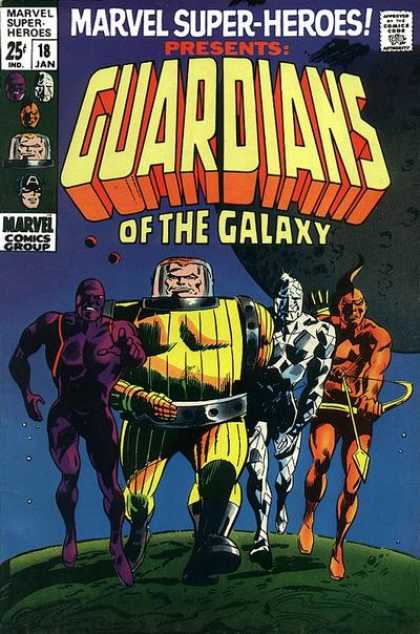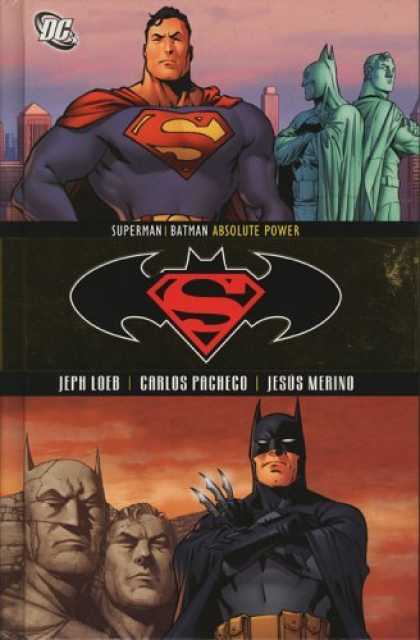 Marvel Super-Heroes #18, January 1969
Marvel Super-Heroes #18, January 1969 Arnold Drake/Gene Colan-Mickey Demeo
I recently picked up the Marvel Premiere Hardcover, Guardians of the Galaxy: Earth Shall Overcome. I recalled the Guardians mainly from the pages of the Defenders, back in my early comics-buying days. When I saw that not only this collection was coming out, but its sequel (Guardians of the Galaxy: The Power of Starhawk), I was very excited to read them. I am a big fan of Marvel's recent strategy of getting not only important storylines from the Bronze Age back into print, but entire runs of short-lived series.
Since we tend to focus mainly on the Silver Age here at TGAGASC, I thought I'd stick to the first appearance of the Guardians from 1968 -- Marvel Super-Heroes #18 (cover-dated January 1969). The tale was authored by Arnold Drake and rendered by Gene Colan and Mike Esposito (under the latter's pen name of Mickey Demeo).
Arnold Drake, creator of the Doom Patrol and Deadman, was a longtime writer for DC Comics who fell out of favor with editorial toward the end of the 1960's. Shortly after seeing his workload dwindle to nothing, he moved over to Marvel Comics, where he created (with Colan) the Guardians. You can read more about Drake in a wonderful obituary penned by Mark Evanier at the following link:
I'll be honest -- this story reads just like a 1960's DC science fiction yarn! Colan's pencils (and I am speaking of figural form, speed lines, etc.) somewhat lend themselves more to the DC style than to what Marvel was then producing. Saying that, however, other than one splash page, there is not a single panel in the story that has right angle corners! Colan was really pushing the envelope with panel lay-outs here. Although there are no characters or backgrounds that break the panel boundaries (as we'd see a little later from not only Colan but also from the likes of Neal Adams, et al.), Colan's style is somewhat unnerving to the unsuspecting reader. A Colan-art veteran, I was nonetheless taken aback by the frenetic pace of the storytelling -- it was as if Drake's words could not keep up with Gene the Dean's pictures!

Drake's characterization is pretty basic. The bad guys, an alien race known as the Badoon, are pretty typically malevolent. They posture, they say all the right (or wrong, I suppose) things, and are pretty menacing in speech and in their looks. The goal of the Badoon is to eradicate the galaxy of humanity. On the other hand, the good guys fall into pretty basic team-book dynamics. It's difficult at this point to tell any pecking order among the four white knights, but it is pretty clear that Yondu the archer will be toward the bottom. I really had to laugh at the total lack of political correctness in Yondu's speech patterns -- reading him here was to "hear" Jay Silverheels speaking as Tonto! It really was funny. Vance Astro is a little bit of a smart aleck, and nowhere near the Captain America-clone he will become in subsequent incarnations of the team. Martinex is basically written as he will be later -- serious, focused.  Charlie-27 is the one character who seems really undefined. He is listed as a survivor of the Jupiter colony, with a mass 11x that of an Earthman. However, the way Colan draws his head is quite odd, as it seems almost to flow -- it certainly changes shapes throughout the story. And, one would think that in spite of his bulk and weight that Charlie-27 possesses super-speed. He is drawn on many pages either with an overabundance of speed lines, and even at times in sequential pictures as if moving faster than the eye could normally follow -- as if he were Quicksilver or the Flash! I never remembered Charlie-27 possessing super-speed in any other stories, and indeed I can find no online references to that power in regard to his character. So perhaps Drake/Colan wanted to tinker with this later...
Charlie-27 is the one character who seems really undefined. He is listed as a survivor of the Jupiter colony, with a mass 11x that of an Earthman. However, the way Colan draws his head is quite odd, as it seems almost to flow -- it certainly changes shapes throughout the story. And, one would think that in spite of his bulk and weight that Charlie-27 possesses super-speed. He is drawn on many pages either with an overabundance of speed lines, and even at times in sequential pictures as if moving faster than the eye could normally follow -- as if he were Quicksilver or the Flash! I never remembered Charlie-27 possessing super-speed in any other stories, and indeed I can find no online references to that power in regard to his character. So perhaps Drake/Colan wanted to tinker with this later...
And that "later" wouldn't come to pass anytime soon. The Guardians, after their one-page, cliffhanger first appearance, would be back-burnered until Steve Gerber chose to unshelve them in 1974. After that, they would appear somewhat regularly as guest-stars in Marvel Two-In-One and the Defenders (1975), before gaining their own series in the pages of Marvel Presents (1977).
 Charlie-27 is the one character who seems really undefined. He is listed as a survivor of the Jupiter colony, with a mass 11x that of an Earthman. However, the way Colan draws his head is quite odd, as it seems almost to flow -- it certainly changes shapes throughout the story. And, one would think that in spite of his bulk and weight that Charlie-27 possesses super-speed. He is drawn on many pages either with an overabundance of speed lines, and even at times in sequential pictures as if moving faster than the eye could normally follow -- as if he were Quicksilver or the Flash! I never remembered Charlie-27 possessing super-speed in any other stories, and indeed I can find no online references to that power in regard to his character. So perhaps Drake/Colan wanted to tinker with this later...
Charlie-27 is the one character who seems really undefined. He is listed as a survivor of the Jupiter colony, with a mass 11x that of an Earthman. However, the way Colan draws his head is quite odd, as it seems almost to flow -- it certainly changes shapes throughout the story. And, one would think that in spite of his bulk and weight that Charlie-27 possesses super-speed. He is drawn on many pages either with an overabundance of speed lines, and even at times in sequential pictures as if moving faster than the eye could normally follow -- as if he were Quicksilver or the Flash! I never remembered Charlie-27 possessing super-speed in any other stories, and indeed I can find no online references to that power in regard to his character. So perhaps Drake/Colan wanted to tinker with this later...And that "later" wouldn't come to pass anytime soon. The Guardians, after their one-page, cliffhanger first appearance, would be back-burnered until Steve Gerber chose to unshelve them in 1974. After that, they would appear somewhat regularly as guest-stars in Marvel Two-In-One and the Defenders (1975), before gaining their own series in the pages of Marvel Presents (1977).
 If you're a fan of the Bronze Age, or of science fiction, or just of today's Guardians (which I admittedly know nothing of), then you should seek out this hardcover. For my money, I wouldn't plunk down any change just for Marvel Super-Heroes #18, but for the added content the collection was the way to go.
If you're a fan of the Bronze Age, or of science fiction, or just of today's Guardians (which I admittedly know nothing of), then you should seek out this hardcover. For my money, I wouldn't plunk down any change just for Marvel Super-Heroes #18, but for the added content the collection was the way to go.



 I use Art Spiegelman's Maus with my own freshmen-level classes, and I've cited that graphic novel as well as Will Eisner's The Plot (an extensive look at the writing and desemination of The Protocols of the Learned Elders of Zion) in my senior-level Social Injustice class. I just finished reading Magneto: Testament, and I want to recommend it to you. The edition I read is hardcover, runs $25 retail, and reprints the five issues of the mini-series that was published in 2008. It also includes historical endnotes and a teacher's guide. While I didn't wholeheartedly agree with all of the lesson suggestions, it would still be a welcome resource for many educators.
I use Art Spiegelman's Maus with my own freshmen-level classes, and I've cited that graphic novel as well as Will Eisner's The Plot (an extensive look at the writing and desemination of The Protocols of the Learned Elders of Zion) in my senior-level Social Injustice class. I just finished reading Magneto: Testament, and I want to recommend it to you. The edition I read is hardcover, runs $25 retail, and reprints the five issues of the mini-series that was published in 2008. It also includes historical endnotes and a teacher's guide. While I didn't wholeheartedly agree with all of the lesson suggestions, it would still be a welcome resource for many educators.


